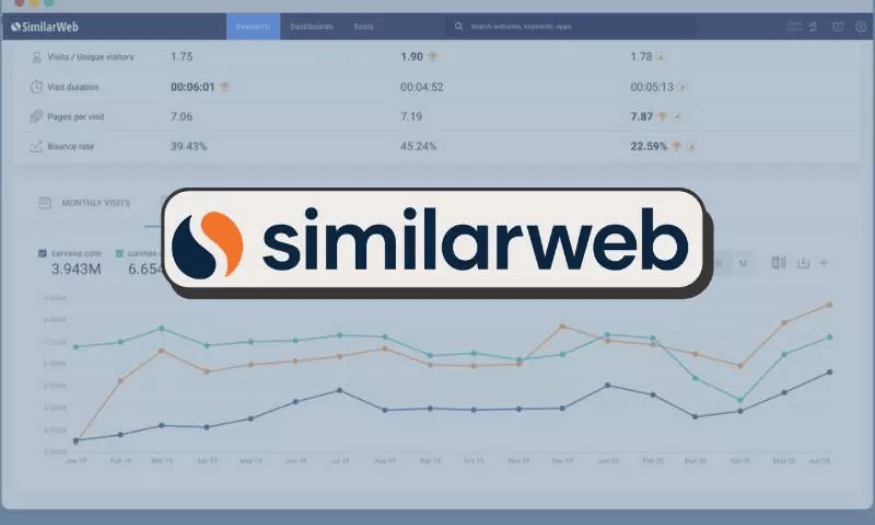Best Selling Products
11 Steps to Analyze Your Competitors' Websites with Similarweb Tool
Nội dung
- 1. Identify competitors
- 2. General research on competitors
- 3. Check your competitors' websites
- 4. Market approach strategy analysis
- 5. Define customer persona and journey
- 6. Products and prices
- 7. Read customer reviews
- 8. Discover the most effective marketing channels
- 9. Social media monitoring and measurement
- 10. Keyword strategy
- 11. Benchmark against key engagement metrics
- 12. Conclusion
In today’s business world, staying informed about your competitors is extremely important. With the help of analytics tools, you can not only better understand your competitors’ strengths and weaknesses, but also be flexible in adapting to market fluctuations. Similarweb is a useful tool that helps you do this effectively.

In today’s business world, staying informed about your competitors is extremely important. With the help of analytics tools, you can not only better understand your competitors’ strengths and weaknesses, but also be flexible in adapting to market fluctuations. Similarweb is a useful tool that helps you do this effectively.
In this article, Sadesign will guide you through 11 specific steps to analyze your competitors' websites through Similarweb. You will find useful tips and free analysis templates, helping you easily compare your business with your competitors. Follow along to discover how to analyze your competitors' websites, thereby making accurate decisions to promote sustainable development for your business.
1. Identify competitors
To begin your competitor analysis journey, the first step you need to take is to identify companies that offer products or services similar to yours. Categorizing these competitors according to three key factors will give you a deeper understanding of the market. These are: their target audience, the problem they solve, and the product they offer.
Your direct competitors will be similar businesses in all three of these areas. They target the same customers, solve similar problems, and have similar product portfolios. Meanwhile, your indirect competitors may be similar in only two areas, creating unique opportunities and challenges for your strategy.
.png)
2. General research on competitors
Once you have identified your competitors, the next step is to gather information about them. Analyzing three to five companies in each group will give you a clear picture of the competitive landscape. Take note of each competitor’s strengths and weaknesses, and then formulate a strategy that works for your business.
Basic information to gather includes company size, geographic location, number of employees, and year of establishment. It is also important to determine their market position and market share. You need to consider their brand awareness, product range, and distribution methods, including accessibility via mobile apps.
3. Check your competitors' websites
Your competitors’ websites are a treasure trove of information that you should not ignore. Start by examining their site structure: do they have separate pages for each product, industry, or service? Is there a blog, and if so, what is the main content?
Also, pay attention to the calls to action (CTAs) they use. Do they offer any free resources or services, such as reports or consultations? The live chat feature is also an important point to consider. This not only gives you a better understanding of how they interact with customers, but also shows how much they care about customer service.
In particular, don’t forget to monitor the communication channels they use such as Facebook, Email, or Zalo. Each competitor will have their own strengths and weaknesses in the way they market, and identifying their Unique Selling Proposition (USP) will open up opportunities for you. Find out what factors make each competitor different, and then plan your own strategy.
.png)
4. Market approach strategy analysis
The next step in your competitor analysis journey is to understand the strategies they use to attract potential customers. To understand this process, you should put yourself in the shoes of your customers and explore the sales channels they use. Read some of their blog posts or even sign up and experience the products/services they offer.
Your goal in this stage is to understand what problems your competitors are solving for their customers. You need to identify their Unique Selling Proposition (USP) and how they are communicating their key messages to consumers. Don’t forget to look at the referral marketing channels they use, as well as how they serve their customers through their website or app. This will give you a better idea of how they build relationships with their customers.
5. Define customer persona and journey
Competitor analysis goes beyond just looking at their websites; you need to understand more about the demographics they’re targeting. By doing a thorough analysis, you can determine whether factors like gender and location influence the customer journey. This will help you build a clearer picture of your target audience.
However, to get a complete picture, you need to extend your analytics beyond your website. Today, information coming from mobile apps is just as important. With the growing trend of consumers using mobile devices, tracking the customer journey across these platforms is essential. According to data from Similarweb, the share of mobile traffic has increased to 65%, showing that you need to focus on app analytics in your strategy.
.png)
6. Products and prices
The next step in the analysis process is to learn about your competitors’ products and pricing policies. Specifically, you need to see what products your competitors offer, how they cost, and how they distribute them. It’s important to evaluate whether their pricing structure has different tiers, as well as incentives like discounts, freebies, or free trials.
Looking at their refund policies and FAQs on their websites will also give you insight into how they operate. Pricing analysis will not only help you understand your competitors’ business models, but will also show you how their pricing strategy reflects their target audience and messaging. This will help you reshape your own strategy to stay competitive.
.png)
7. Read customer reviews
How a company presents itself is important, but a customer perspective offers a whole other perspective. To get a better idea of how your competitors are performing, you should look at consumer reviews and ratings. Not only will this feedback help you gauge the appeal of your product, it can also reveal any weaknesses your competitors may have.
Look for issues and questions that users are asking in forums or review groups. This will help you identify areas where your competitors are not doing well. In particular, if your competitors have a mobile app, reading reviews of that app will help you identify missing features or common complaints from users. All of this information will be useful tools for you to adjust your strategy.
8. Discover the most effective marketing channels
Once you’ve done the previous analysis, you’ll have a clear picture of the marketing channels your competitors are leveraging. You can identify the social media platforms they use, as well as the email marketing campaigns or newsletters they send to their customers.
Next, find out if your competitors are using pay-per-click (PPC) advertising. You can easily identify their ads by typing their brand or product name into Google. Don’t forget to investigate their affiliate programs and how much traffic they get from these sources. All of this data will help you determine which channels are really effective in generating traffic and leads.
9. Social media monitoring and measurement
When looking at your competitors’ social media activity, you need to look not only at their follower count but also at their engagement levels. Pay attention to what types of content engage users, as well as how they interact with the posts: Likes, comments, or shares.
Using Similarweb, you will get specific metrics on your competitors’ engagement levels. This data will help you compare the effectiveness of their social media marketing strategies to what you are doing. From there, you can learn valuable lessons and adjust your strategy to increase your reach and engagement with your target audience.
10. Keyword strategy
Researching your competitors’ SEO strategies is an essential part of competitive analysis. Identifying the keywords they are focusing on opens up many opportunities for you to optimize your marketing strategy. Depending on your product or service category, there are a variety of keywords that can drive traffic and increase page views.
Using Similarweb’s Keyword Research Tool will give you insight into how much traffic each keyword brings to specific websites. You’ll easily find information about a website’s position in search results, related landing pages, cost per click (CPC), and search volume for the keyword. All of this data will help you build a stronger keyword strategy.
.png)
11. Benchmark against key engagement metrics
Once you have completed the analysis steps, you will have a rich set of data to evaluate the performance of both your business and your competitors. Creating a spreadsheet to track this information will make it easier for you to compare and analyze. You can use the competitor analysis template available on our website to save time.
When you look at your data against your competitors’ metrics, you’ll gain a better understanding of where you stand in the market. This will help you identify the strengths, weaknesses, opportunities, and threats your business faces. This benchmarking not only gives you a clearer view of the competitive landscape, but also allows you to adjust your strategy to optimize your business performance.
12. Conclusion
Competitor analysis is not a one-time thing but needs to be done regularly. This helps you stay updated and aware of the latest trends, thereby optimizing your business strategy. Equip yourself with the necessary knowledge and tools to continuously develop and strengthen your competitive position in the market.












































